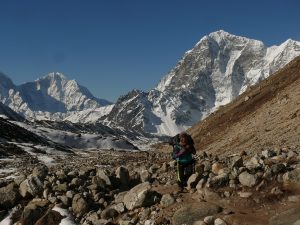On July 27, 150 people tried to summit K2, the second-tallest mountain in the world, walking over Mohammad Hassan.
Hassan, a Pakistani porter who carried equipment for the rope-fixing team, had fallen off the trail. Climbers pulled him up after some struggle, but he could neither talk nor walk on his own. Climbers could not see a way “of carrying Hassan with five or six people without risking rescuers’ life.” He finally passed away.
The incident happened at the Bottleneck, considered the most dangerous part of the notoriously hazardous K2. The treacherous conditions meant that the climbers who were in a long queue at Bottleneck, were in danger and needed to move. Thus, many walked over Hassan to scale the summit.
Drone footage of climbers walking over Hassan circulated, sparking a media frenzy and criticism directed at Norwegian mountaineer Kristin Harila and her team for prioritizing her attempt “to become world’s fastest climber to scale all peaks above 8,000 meters over Hassan’s life.”
Later, Harila explained that her team carried out a nearly two-hour rescue attempt. She had left Sherpas by Hassan’s side while the rest of the team ascended to the top, she said.
In Harila, people around the globe found a convenient face of the “villain” to pin the blame on. Her skin color and European descent might have also played a role in people readily accepting that she and her team ignored Hassan’s life based on short footage. This also reflects that people have shorter attention spans and are quicker to judge via clips seen on social media.
This tale hit closer to home for Nepalis because Sherpas have been an integral part of expeditions to mountain summits in Nepal or abroad. Every year, scores of climbers and Sherpas, who provide vital logistical support to the climbers, face death while climbing Sagarmatha, as Everest is known in Nepal.
However, the narrative that their deaths are because of some climbers with money putting their ambitions above the safety of the aides is incomplete at best and self-serving at worst.
Firstly, the tales of death while climbing mountains are not unique. K2 is among the most perilous mountains to climb. One in four climbers of K2 died during the assent before 2021. In contrast, Sagarmatha’s death rate is “only” 3 percent.
In 2023, 17 climbers died while climbing Sagarmatha due to inclement weather. Over the past century, there have been 315 deaths on Sagarmatha, of which one-third are Sherpa guides. There is inherent risk in climbing these summits. This applies to climbers as well as their porters.
Secondly, the Sherpas or the porters earn a good income by participating in the mountaineering expeditions. A Sherpa earns around $5,000, excluding tips and bonuses, compared to Nepal’s GDP per capita of around $1,300 in 2022. However, they have minimal job and income security, especially in cases of death or injury. Nevertheless, Sherpas take exceptional pride in their ability to climb tall mountains. Their valor has been recognized worldwide, and the community is respected. Earlier this year, a Nepali Sherpa guide was recognized globally for his audacious rescue of a Malaysian climber at a high altitude in Sagarmatha.
Thirdly, it is unfair to allege that most mountaineers climbing the tallest mountains of the world are there primarily for bragging rights or are high earners seeking fame on the backs of Sherpas. They know the mountains are perilous, and require mental and physical doggedness and a big slice of luck for a successful ascent of a summit.
However, there are structural and ethical issues that merit attention. The number of deaths on the Sagarmatha has generally remained high in the last few decades. This is partly because the number of people permitted to climb the Sagarmatha has increased. In 2023, Nepal issued almost 400 permits, a record for a climbing season.
It generates millions in revenue for the country and jobs for mountaineers and ancillary businesses. However, it has led to extremely long queues during the ascent. Such queues increase the risk of deaths and obfuscate rescue efforts if needed.
The risk is furthered by “rookie” mountaineers. Many guide companies accept mountaineers with a minimal experience for the lure of money. Some climbers have made an audacious attempt to scale the mountains despite their physical limitations, risking their and support staff’s lives. Others have sought a “luxurious” climb by paying for their way to the top.
Such climbers have to be filtered out beforehand. Multiple experiences in scaling other mountains of lesser heights should be a qualifying factor for any mountaineer to be permitted to climb mountains of 8,000+ meters altitude. This will ensure that mountaineering will continue to bring in revenue even as it reduces the pressure and chaos atop Sagarmatha and other mountains.
Then, there are ethical issues about the exploitation of Sherpas. They have limited social security and need to be paid more. Similarly, filtering out inexperienced climbers in advance would mitigate some risks for the Sherpas.
Rescue efforts carry several ethically tricky issues. Rescuers face risks in such efforts, especially at higher altitudes. After a certain point, they must choose between attempting the rescue or saving their own lives (and potentially of other mountaineers).
In such cases, right and wrong are blurred, and the climbers/guides should be cut some slack. Such cases will test the mental fortitude of the climbers. After all, climbing Sagarmatha is the Everest of challenges, physically and mentally.

































